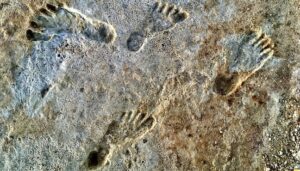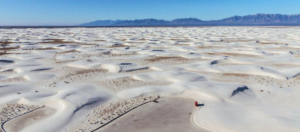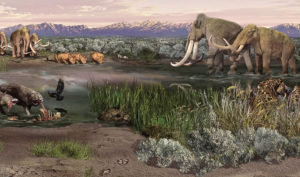
Anyone who visits White Sands National Park in south central New Mexico cannot help but marvel at the stark yet uniquely beautiful, undulating formations of white, rich gypsum crystal sand dunes that make it stand out from most any other arid landscape on the planet. It is what draws its thousands of visitors every year. It spreads over 145,762 acres or 227.8 square miles within the Tularosa Basin, a vast geologic graben that lies between the Sacramento Mountains to the east and the San Andres and Oscura Mountains to the west. White Sands is the largest of its kind anywhere on Earth, its gypsum sand depth extending as much as 30 feet and its dunes reaching a hight as much as 60 feet — a mass of 4.1 billion metric tons. Despite its aridity, among its dunes live mammal populations of fox, rodents, coyotes, bobcats, badgers, rabbits, and porcupines; along with seven species of amphibians; reptiles, including a variety of lizards and snakes; and 220 species of birds. Cacti, desert grasses, and even some trees and shrubs pockmark the landscape — tracks of small animals can even be seen leading from plant to plant.
_________________________________

Aerial view of White Sands. Wikimedia Commons, Public Domain
_________________________________
But rewind backward over 12,000 years, and one sees a very different world. During the late Pleistocene, before the end of the Last Glacial Maximum (or LGM), the land here was characterized by lakes, rivers and streams. Vegetation was significantly more lush. It supported such animal species as mammoth, giant ground sloth, and dire wolves, mammals now long extinct. We know this because teams of scientists and specialists have spent years in the region surveying, excavating, and studying recovered finds that attest to this ancient reality. One of many locations in the region has revealed evidence of a great ancient inland body of water known to paleoclimatologists and paleontologists as Lake Otero, the largest of several lakes that characterized the Tularosa Basin between 36,000 and 19,000 years ago. Here, on what is today a dried up ancient lakebed known as a playa, teams of paleontologists and other specialists have revealed evidence for extinct late Pleistocene fauna such as mammoth, groundsloth, canid and felid carnivora (such as the dire wolf and the saber-toothed cat), bovids and camelids (such as ancient cattle species and ancient camels).
In January of 2020, one team of scientists uncovered something quite remarkable at a site they designated WHSA (White Sands) Locality 2 ………..
_________________________________

Artist recreation of late Pleistocence landscape in present-day White Sands National Park. Wikimedia Commons, Public Domain
_________________________________
An Extraordinary Trackway Exposed
It was in 2019 when a research team consisting of a core group of specialists—Dan Odess and David Bustos from the National Park Service, Kathleen Springer and Jeff Pagati from the US Geological Survey, Tommy Urban from Cornell University, and Matthew Bennet of Bournemouth University, discovered what appeared to be human footprints among those of what they knew to be extinct megafauna. Battling arid conditions and windblown sand, in January of 2020 they meticulously excavated and eventually revealed human, proboscidean (such as mammoths), and canid (such as dire wolf) footprints in all layers or levels throughout their trenching. But of particular interest were the human tracks — no less than 61 in all — showing, according to the researchers, “good anatomical definition”, meaning they exhibited good heel impressions, toe pads and longitudinal arch definition consistent with modern Homo sapiens footprints as well as human footprints documented at other Pleistocene sites across the world. Most important, the team was able to establish a controlled chronology for the footprints by dating their sediment context using radiocarbon ages of sediment samples containing macroscopic seeds of the aquatic plant Ruppia cirrhosa (from beds of ditch grass seeds) which sandwiched the relevant footprint-bearing layers. The dating sequence yielded calibrated ages from 22.86 ± 0.32 to 21.13 ± 0.25 ka.*
In other words, there may have been humans at this location 23,000 years ago, and perhaps even earlier.
_____________________________
Read much more, including the latest update, in the complete premium article.
Cover Image, Top Left: Human fossil footprint tracks at the site. Courtesy Dan Flores.
_____________________________
Advertisement

EXPLORE THE ANCIENT ETRUSCANS IN PERSON!
Experience a unique, up-close-and-personal hike among ancient hilltop towns in central Italy. You will walk the sensational countryside of the regions of Umbria and Tuscany, soaking in important sites attesting to the advanced Etruscan civilization, forerunners of the ancient Romans; imposing architectural and cultural remains of Medieval Italy; local food and drink; and perhaps best of all — spectacular scenic views! Join us in this collaborative event for the trip of a lifetime!



